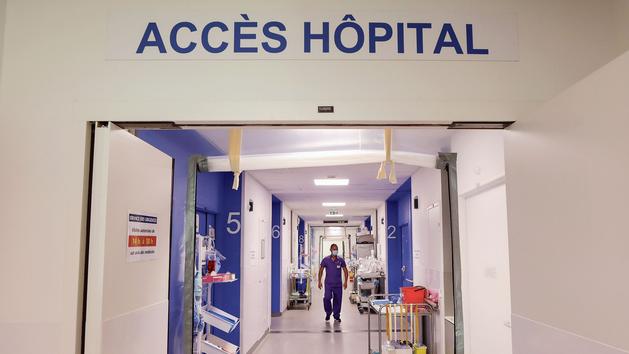"
We are in a strong second wave."
At the top of the state, the tone has changed, as evidenced by this statement by the Prime Minister.
We are far from the astonishment of the month of March in the face of an uncontrolled spread of Sars-CoV-2;
but the
"thrills"
of July have become groundswell.
Today, the proportion of positive cases among all those tested continues to increase at 11.8%, while the weekly incidence at the national level exceeds 165 cases of Covid-19 per 100,000 inhabitants.
The priority given to screening symptomatic people should certainly amplify this increase, but the epidemic continues to progress, stimulated in recent days by the onset of cold and shorter days: we spend more time in an enclosed environment, we ventilate less. .
Read also:
Is the Covid "50 to 100 times less lethal" today than in March?
As in the first wave, the situation varies from one department to another: in Gironde, for example, the signals are encouraging, but in certain metropolises in the maximum alert zone, and more particularly in Paris, Lille and Lyon , the situation is deteriorating sharply.
In the capital, one of the most densely populated cities in the world, the rate of positive tests is close to 17% and the incidence exceeds 410 cases per 100,000 inhabitants per week.
It explodes in 20-30 year-olds, with more than 645 cases per 100,000… ie 13 times the alert threshold set at 50.
“All this was foreseeable, from July”
, deplores Mircea Sofonea, lecturer in epidemiology at the university of Montpellier.
However, the current curve is much more flattened than that of spring.
We are, according to him,
"on figures comparable to those of March 10 in terms of incidence, but the epidemic is progressing 4 to 5 times more slowly thanks to the brakes represented by wearing a mask or tracing".
In town, general practitioners see patients flocking:
“We have an increase of 20 to 30%,
indicates Dr. Jérôme Marty, president of the UFML doctors' union.
Usually when you have a little headache you just wait for it to pass.
There, people consult. ”
Similar profiles
The number of serious cases is also increasing and hospitals are inexorably filling up, with patients with profiles similar to those of the first wave.
The health authorities thus identified 1,539 Covid patients in intensive care on Monday evening.
More than one in five intensive care beds is already occupied by a patient with coronavirus, out of a current capacity of 5,800 beds.
And if nothing changes
, "we could reach this number in November"
, estimates Mircea Sofona.
More than a wave, caregivers also speak of a tide, with once again great disparities: barely 13% of intensive care beds are occupied in the Pays de la Loire and less than 10% in the Grand Est, according to data from the government.fr website.
In Ile-de-France, on the other hand, more than 40% of these beds are occupied by Covid patients.
These are
"probably up to 300 people per day in the coming days who will arrive in hospitals"
in the region, predicted the director of the Regional Health Agency, Aurélien Rousseau, on BFMTV.
We were amazed, in May, to see that the scaffolding that had taken weeks to erect was so quickly undone.
Djillali Annane, head of the intensive medicine and resuscitation service at Raymond-Poincaré de Garches
At the Raymond-Poincaré hospital in Garches (Hauts-de-Seine), Professor Djillali Annane, head of the intensive medicine and resuscitation service, is sailing on sight:
“Our 15 beds - including 9 Covid - are full.
A bed that becomes available is occupied in less than 24 hours. ”
Éric Maury, president of the French Language Resuscitation Society (SRLF), for his part describes a
“heterogeneous
situation
in Paris: at Bichat hospital (north), they have been calling for help for 15 days.
The south of the capital is for the moment less impacted ”.
All deplore the lack of anticipation.
"We were stunned, in May, to see that the scaffolding that had taken weeks to erect was so quickly
undone,
"
explains Djillali Annane, who chairs the national union of resuscitators of public hospitals.
He points above all to a staff problem in intensive care units where at least two nurses are needed for five patients.
Because, in hospitals, the sacred union has lived.
The establishments under stress are deprogramming operations, but after having had to make up for the delay accumulated in recent months, the others continue to operate at full speed for Covid patients or not.
There is therefore little room for maneuver.
"The health reserve is exhausted, and the reinforcements coming from the regions, it's over,"
adds Professor Annane, who points to the fatigue and the fed up of the teams.
“Some who helped us in April warned us: they won't come back.
They are traumatized. ”
Read also:
Covid-19: despite the understaffing, hospitals better prepared for a second wave
In theory, however, assures the DGS,
"operations of the 'medical evacuations' type are always part of the range of actions that could be implemented".
The All Saints holidays, very family, will not help.
Mixing of populations, increased risk of intergenerational transmission ... The executive wants to count on the responsibility of each one, but the message, Wednesday evening, will have to be strong.

